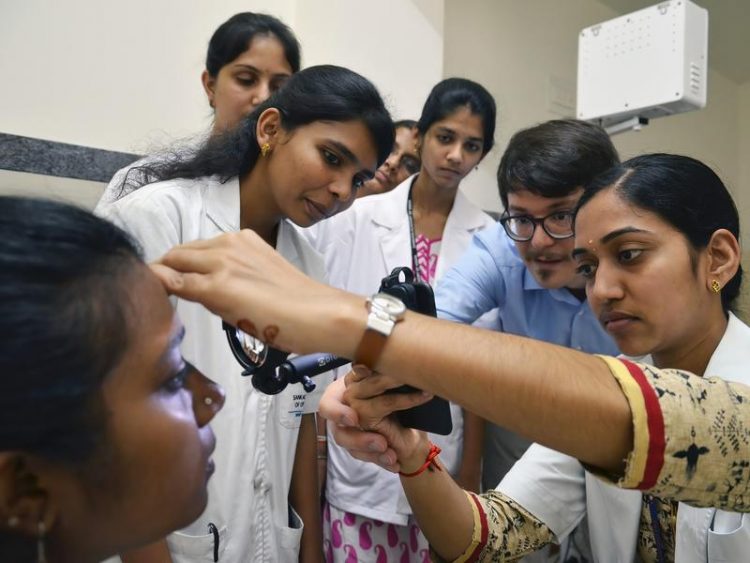Inexpensive retinal diagnostics via smartphone

The smartphone in ophthalmological use: Dr. Maximilian W. M. Wintergerst (second from right) trains ophthalmic assistants at the Sankara Eye Hospital in Bangalore, India. Copyright © Universität Bonn
One of the most dangerous long-term complications of diabetes is vascular damage. In the eye's photosensitive layer, the retina, this also impacts the capillaries. This network of small vessels supplies the sensory cells with oxygen and nutrients.
If it deteriorates, abnormal new vessels form instead and further harm the damaged retina. Left untreated, this often result in loss of vision and ultimately blindness.
“If such a retinopathy is recognized and treated in time, vision loss can often be prevented,” emphasizes Dr. Maximilian Wintergerst from the Department of Ophthalmology at the University Hospital Bonn.
“An important aspect of therapy is better control of the diabetes; in addition, it is also possible to treat the undersupplied retina with laser light before further problems occur.” Laser treatment destroys the undersupplied retina so that it can no longer cause problems by releasing growth factors. These can otherwise cause the formation of abnormal vessels and fluid accumulation in the retina.
Screening alternative with potential
A lack of exercise and an increasingly high-calorie diet mean that diabetes is currently on the rise globally. It is estimated that 8 out of 10 people with diabetes worldwide live in developing and emerging countries, which often have a poorly resourced health system. Systematic retinal screening of diabetics is therefore usually not possible in these countries.
This could be overcome by using devices that were actually designed for a completely different purpose – smartphones. The increasingly affordable devices nowadays usually come with high-quality cameras. And these are surprisingly useful for diagnosing diseases of the retina. The current study conducted by Wintergerst together with colleagues from Bonn and Bangalore in southern India points in this direction.
In the study, the researchers compared four different approaches aimed at enabling ophthalmoscopy with a standard mid-range smartphone. Not all of them fulfilled this promise equally well.
“The best result in our test was achieved by an adapter with an additional lens that is attached to the smartphone,” Wintergerst concludes. “It allowed almost 80 percent of eyes with any retinal changes to be detected, even in the early stages. Advanced damage could even be diagnosed 100 percent of the time.”
The scientists had trained optometrists (ophthalmic assistants) from the Sankara Eye Hospital in Bangalore for their study. On average, they needed one to two minutes per examination. This involved documenting changes in the retina by filming the back of the eye with a smartphone camera.
The co-author of the study, Prof. Dr. Robert Finger from the Department of Ophthalmology at the University Hospital Bonn, considers these capabilities to be what makes the method so appealing: “This means that the examination can also be enabled by trained laypersons,” he says. “The images are then sent via the Internet to the ophthalmologist for diagnosis.”
“COVID-19 has further necessitated the need for us to explore methods of reducing patients visiting hospital. This modality is promising in increasing efficiency of screening for retinal changes in diabetics”, added co-author Dr. Mahesh P. Shanmugam, Head VitreoRetina & Ocular Oncology, Sankara Eye Foundation India.
Next step: artificial intelligence supports diagnostics
The researchers are currently developing an app in collaboration with their colleagues from the Sankara Eye Foundation in India. This app will make it possible to create an encrypted electronic patient file for each patient on the smartphones used for the examination.
It not only stores the images, but also the findings of the doctor who ultimately reviewed them. Furthermore, the researchers are working on an automatic pre-evaluation of the images using artificial intelligence. In such methods, a software “learns” to recognize pathological changes independently on the basis of thousands of retinal images.
The researchers hope that their work will improve eye care in developing and emerging countries. The project is funded by the German Federal Ministry for Economic Cooperation and Development and the Else Kröner-Fresenius Foundation. Recently, it was also presented with the special award of the “bytes4diabetes Award” for innovative digital approaches in the fight against diabetes.
Dr. Maximilian W. M. Wintergerst
Universitäts-Augenklinik Bonn
Tel. +49(0)228-28715505
E-mail: Maximilian.Wintergerst@ukbonn.de
Maximilian W. M. Wintergerst, Divyansh K. Mishra, Laura Hartmann, Payal Shah, Vinaya K. Konana, Pradeep Sagar, Moritz Berger, Kaushik Murali, Frank G. Holz, Mahesh P. Shanmugam*, Robert P. Finger*: Diabetic retinopathy screening using smartphone-based fundus imaging in India; Ophthalmology, *these authors contributed equally, DOI: 10.1016/j.ophtha.2020.05.025
http://www.aaojournal.org/article/S0161-6420(20)30463-2/fulltext
Media Contact
More Information:
http://www.uni-bonn.de/All latest news from the category: Medical Engineering
The development of medical equipment, products and technical procedures is characterized by high research and development costs in a variety of fields related to the study of human medicine.
innovations-report provides informative and stimulating reports and articles on topics ranging from imaging processes, cell and tissue techniques, optical techniques, implants, orthopedic aids, clinical and medical office equipment, dialysis systems and x-ray/radiation monitoring devices to endoscopy, ultrasound, surgical techniques, and dental materials.
Newest articles

Parallel Paths: Understanding Malaria Resistance in Chimpanzees and Humans
The closest relatives of humans adapt genetically to habitats and infections Survival of the Fittest: Genetic Adaptations Uncovered in Chimpanzees Görlitz, 10.01.2025. Chimpanzees have genetic adaptations that help them survive…

You are What You Eat—Stanford Study Links Fiber to Anti-Cancer Gene Modulation
The Fiber Gap: A Growing Concern in American Diets Fiber is well known to be an important part of a healthy diet, yet less than 10% of Americans eat the minimum recommended…

Trust Your Gut—RNA-Protein Discovery for Better Immunity
HIRI researchers uncover control mechanisms of polysaccharide utilization in Bacteroides thetaiotaomicron. Researchers at the Helmholtz Institute for RNA-based Infection Research (HIRI) and the Julius-Maximilians-Universität (JMU) in Würzburg have identified a…



